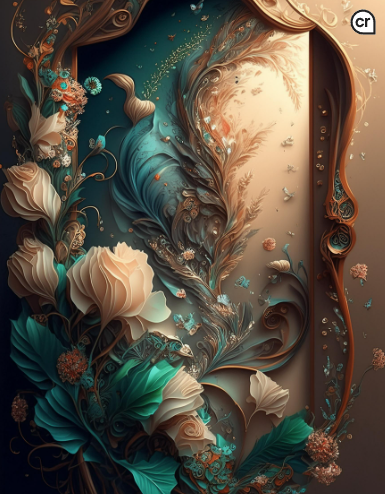The AI Alchemist: How Adobe Firefly Transforms Images with Generative Magic
The world of creative expression is on the cusp of a revolution. AI art generators, once relegated to the fringes of experimentation, are rapidly evolving into powerful tools for artists and designers. Among these advancements, Adobe Firefly stands out as a game-changer, poised to transform how visuals are conceptualized and brought to life.
This suite of generative AI models, currently in beta testing, promises to act as an intelligent assistant within the familiar environment of Adobe Creative Cloud applications. Firefly goes beyond the limitations of traditional AI art generators, which often focus solely on creating entirely new images based on text descriptions. Instead, it seamlessly integrates with existing workflows, particularly within Photoshop, empowering users to leverage the power of artificial intelligence to enhance and manipulate existing visuals with unprecedented ease.

The AI Alchemist: How Adobe Firefly Transforms Images with Generative Magic
The world of design is witnessing a transformative era with the rise of powerful AI art generators. Among these innovative tools, Adobe Firefly emerges as a groundbreaking solution, empowering artists and designers to unlock new creative possibilities. This suite of AI models, currently in beta, boasts a range of features that redefine how we interact with and manipulate visuals. Let’s delve into the key functionalities of this generative magic:
1. Generative Fill: Bridging the Gaps with AI
Imagine effortlessly completing empty spaces in your images. With Firefly’s “Generative Fill,” this becomes a reality. Describe what you want to add to a scene using natural language prompts. Firefly then analyzes the existing elements with remarkable intelligence. It then generates content that seamlessly blends with the existing image, maintaining style and realism. Think adding a majestic mountain range to a landscape photo or seamlessly removing unwanted objects from a portrait – all within seconds.
2. Content Enhancement: Fine-Tuning Your Vision
Firefly’s capabilities extend far beyond simple image completion. It empowers you to enhance existing content with incredible precision. Imagine adjusting lighting and weather effects within your photos, or modifying the shape and form of objects. This allows for unparalleled creative exploration and fine-tuning of visuals to perfectly match your vision.
3. Seamless Integration with Adobe Ecosystem: A Familiar Playground for Creativity
Unlike some standalone AI art generators, Firefly integrates seamlessly within the existing Adobe Creative Cloud workflow. This is particularly beneficial for professional designers and photographers who already rely on Photoshop and other Adobe applications. Firefly acts as an extension of their familiar tools, allowing them to leverage AI capabilities without disrupting their established workflows.
4. Text-to-Image: A Spark for Inspiration
While Firefly’s core strength lies in manipulating and enhancing existing visuals, it also offers a taste of text-to-image generation. Imagine sparking your creative process by describing a scene or concept with words. Firefly can then use this text prompt as a starting point, generating an image that serves as a foundation for further refinement.
5. Beyond Text-to-Image: A Focus on Manipulation and Enhancement
It’s important to note that Firefly’s primary focus remains on manipulating and enhancing existing visuals. This makes it a valuable asset for artists and designers who want to refine and elevate their existing work, while text-to-image generation provides a springboard for new ideas.
Unleashing the Power of AI
Adobe Firefly represents a significant leap forward in AI-powered creative tools. While still under development, it offers a glimpse into the future of design, where human creativity is augmented by the power of intelligent assistance. With its innovative features and seamless integration within the Adobe ecosystem, Firefly has the potential to revolutionize the way artists and designers create and manipulate visuals. As this technology matures, it will be exciting to see how it continues to shape the landscape of digital art and design.

Navigating the Canvas: Understanding the Terms of Use for Adobe Firefly
The world of design is embracing the artistic potential of AI art generators. Among these innovative tools, Adobe Firefly stands out, offering artists and designers a powerful suite of AI models to manipulate and enhance visuals. However, as with any powerful tool, understanding the terms of use (TOU) is crucial for responsible and ethical use.
Ownership and Copyright Considerations
Firefly’s TOU likely address ownership and copyright of the content generated using its AI models. While Firefly may strive to ensure outputs don’t infringe on existing copyrights, it’s ultimately the user’s responsibility to ensure the generated content is original or falls under fair use guidelines. This becomes particularly important when incorporating AI-generated elements into commercial projects.
Attribution and Transparency
The TOU might also address attribution. When using Firefly-generated content, it’s essential to be transparent about the role AI played in the creation process. This fosters trust with audiences and avoids potential copyright issues.
Data Privacy and Security
As an AI tool, Firefly likely interacts with user data. The TOU should outline how user data is collected, stored, and used. Understanding these details empowers users to make informed decisions about their privacy and security.
Limitations and Warranties
Firefly is still under development, and the TOU will likely acknowledge limitations in its capabilities. Additionally, disclaimers regarding warranties are common, highlighting that Firefly is offered “as is” and users are responsible for the outcomes achieved with the tool.
Staying Informed
Since AI technology is rapidly evolving, it’s important to stay informed about updates to the TOU. Adobe might revise the terms to reflect changes in the technology or address emerging legal considerations. Regularly reviewing the TOU ensures you’re using Firefly in accordance with the latest guidelines.
By understanding these key aspects of the TOU, artists and designers can leverage the power of Adobe Firefly responsibly and ethically, unlocking its creative potential while respecting intellectual property rights and user privacy. As AI art generation continues to evolve, responsible use will be essential for building trust within the design community and fostering a vibrant future for AI-powered creativity.

Decoding Creativity: Unveiling Adobe Firefly’s Paid Plans and Pricing Structure
Adobe Firefly, a suite of generative AI models currently in beta, is making waves in the creative world. This innovative tool empowers artists and designers to manipulate and enhance visuals with unparalleled ease. But what if the free tier’s features aren’t enough? Let’s delve into the paid plans offered by Adobe Firefly.
Plan Breakdown
The image you provided appears to showcase two paid plans alongside a free plan:
- Adobe Firefly Premium is priced at $4.99 USD per month (including VAT). This plan grants you 100 generative credits each month. It also includes some additional benefits not found in the free tier, such as removing watermarks from generated images and access to Adobe Fonts.
- Adobe Express Premium is priced at $11.99 USD per month (including VAT). This plan offers the most generative credits at 250 credits per month. It also includes all the benefits of the Adobe Firefly Premium plan, along with a plethora of features from Adobe Express Premium, such as premium social media templates, stock photos, videos, and music.
Understanding Generative Credits
One key concept to grasp with Firefly’s paid plans is generative credits. These credits essentially act as tokens that allow you to generate images using the AI models. The free plan grants a limited number of credits, while paid plans offer a set amount each month. Once you’ve exhausted your credits, you’ll experience limitations, such as slower processing times or a daily generation cap until the month resets.
Choosing the Right Plan
The best plan for you depends on your individual needs. If you’re a casual user who just wants to experiment with Firefly’s capabilities, the free tier might suffice. However, if you’re a professional designer or artist who anticipates using Firefly regularly, a paid plan is likely more suitable. The Adobe Express Premium plan offers the most value if you already use or plan to use other Adobe Express features.
The Future of AI-Powered Design
With its accessible pricing and innovative features, Adobe Firefly is poised to democratize AI-powered design tools. By understanding the paid plans and their limitations, you can leverage Firefly’s potential to streamline your workflow and bring your creative vision to life. As AI technology matures, it will be exciting to see how these tools continue to transform the design landscape.

Fireflies in Your Toolbox: Weighing the Pros and Cons of Adobe Firefly
The world of design is abuzz with the arrival of Adobe Firefly, a suite of AI models that promises to revolutionize workflows. This AI art generator empowers artists and designers to manipulate and enhance visuals with remarkable ease. However, before diving headfirst into this AI-powered future, it’s crucial to weigh the pros and cons of Firefly.
Pros:
- Effortless Image Enhancement: One of Firefly’s biggest strengths lies in its “Generative Fill” feature. Imagine effortlessly filling empty spaces in your images with realistic content that seamlessly blends with the existing style. This opens doors for quicker completion times and removes tedious editing tasks.
- Content Manipulation and Refinement: Firefly goes beyond simple image completion. You can fine-tune lighting and weather effects within photos or modify the shapes of objects with incredible precision. This allows for unparalleled creative exploration and a way to refine and elevate existing work.
- Seamless Integration with Adobe Ecosystem: Unlike some standalone AI art generators, Firefly integrates perfectly within the existing Adobe Creative Cloud workflow. This is a major advantage for design professionals who already rely heavily on Photoshop and other Adobe applications. Firefly acts as an extension of their familiar tools, fostering a smooth transition into AI-assisted design.
Cons:
- Limited Text-to-Image Generation: While Firefly excels at manipulating and enhancing existing visuals, its text-to-image generation capabilities are currently not its primary focus. If you’re looking for an AI tool that solely focuses on creating entirely new images based on text prompts, there might be better options available.
- Beta Testing Stage: As with any new technology, Firefly is still under development. This means users might encounter limitations in functionality, occasional bugs, and a constantly evolving user interface.
- Understanding Generative Credits: Paid plans for Firefly utilize a credit system. These credits limit the number of times you can utilize AI features per month. Understanding how credits work is crucial to avoid running out and experiencing limitations.
The Verdict: A Promising Spark for Creative Minds
In conclusion, Adobe Firefly stands as a promising AI art generator poised to transform the design landscape. Its ability to seamlessly integrate with existing workflows, particularly within the Adobe ecosystem, makes it a valuable asset for professional designers and artists. While the technology is still under development, its core functionalities like “Generative Fill” and content manipulation offer a glimpse into the future of AI-powered creativity. Understanding the limitations of the current beta version, such as the focus on manipulating existing visuals and the credit system for paid plans, is crucial for informed use. As Firefly matures, it has the potential to revolutionize the way we approach image editing and creation, pushing the boundaries of what’s possible within the realm of digital art and design.

Q&A: Demystifying Adobe Firefly ai art generator
Now that we’ve explored the features and considerations surrounding Adobe Firefly, let’s answer some common questions you might have:
Q: What is Adobe Firefly and what does it do?
A: Firefly is a suite of generative AI models developed by Adobe. It’s currently in beta testing and acts as an AI art generator within the Adobe Creative Cloud apps, particularly Photoshop. Firefly empowers users to manipulate and enhance existing visuals using features like “generative fill.”
Q: How does generative AI work in Firefly?
A: Firefly’s AI models analyze existing images and understand their content. You can then use natural language prompts, like “add a majestic mountain range” to a landscape photo, and Firefly generates content that seamlessly blends into the existing image.
Q: Is there a difference between Firefly and Adobe Stock?
A: Yes. Adobe Stock is a platform for royalty-free stock imagery. While Firefly can’t access Adobe Stock directly for image generation, it can potentially help manipulate and enhance existing stock photos you might have downloaded.
Q: Does Firefly work with other Adobe Creative Cloud apps besides Photoshop?
A: Currently, Firefly’s integration is most prominent within Photoshop. However, as the technology evolves, it might be integrated with other Creative Cloud apps like Illustrator in the future.
Q: Can I use Firefly with Adobe Express?
A: While not directly integrated with the free tier of Adobe Express, the paid plan “Adobe Express Premium” offers access to some Firefly features alongside other benefits like premium templates and stock imagery.
Q: Can I use text prompts to generate entirely new images with Firefly?
A: Text prompts are not Firefly’s primary focus. While you can use them as a starting point for image generation, its strength lies in manipulating and enhancing existing visuals. For solely text-based image generation, other AI tools like DALL-E might be a better fit.
Q: Is the content generated by Firefly considered “stock imagery?”
A: No, the generated images are not directly integrated with Adobe Stock. However, understanding copyright and content credentials is crucial for using generated content, especially for commercial use.
Q: Can I use Firefly-generated images for commercial purposes?
A: The terms of use (TOU) will likely outline limitations and considerations for commercial use. It’s essential to be aware of these restrictions to ensure responsible use of generated content.
Q: Can I share openly licensed content generated with Firefly?
A: This depends on the specific license applied to the generated content within the TOU. Firefly might offer options for openly licensed content creation, but understanding the specific limitations is crucial.
Q: Does Firefly offer unique templates like Adobe Express?
A: No, Firefly focuses on image generation and manipulation, not creating templates like Adobe Express. However, it allows users to create new images based on existing visuals, potentially leading to unique design elements.
Q: Where can I find free images to use with Firefly?
A: Many websites offer public domain content or royalty-free images. Using these as a base and manipulating them with Firefly can be a great way to create new visuals.
Q: Can I use Firefly with images from other artists?
A: It’s crucial to obtain permission or use images with appropriate licenses before manipulating them with Firefly. Respecting copyright is essential for ethical use.
Q: What are some new features I can expect from Firefly in the future?
A: As it’s still under development, future features for Firefly are unknown. However, potential advancements might include expanded text-to-image generation, integration with more Creative Cloud apps, and increased control over generated content.
Q: How does using generated content with AI differ from traditional creation?
A: Firefly represents a new tool in the artist’s toolbox. It can enhance existing workflows, spark creative ideas, and help visualize concepts. However, understanding the limitations of AI and maintaining artistic control over the generated content is crucial.
Q: Is Firefly a replacement for traditional art creation?
A: No. Firefly is more like an intelligent assistant, augmenting human creativity. It can help with tasks like refining visuals, generating variations, and overcoming creative roadblocks.
Q: Where can I find more information about Firefly and its features?
A: The official Adobe website or online resources like tutorials and articles can provide the latest information about Firefly. As the technology evolves, staying updated is important.
Hopefully, this Q&A section has clarified your questions about
Rodion Smolyanitskiy
Rodion is a skilled copywriter and AI expert at fancys.ai, specializing in crafting compelling content powered by AI insights. Combining creativity with technical knowledge, Rodion ensures engaging, high-quality copy that resonates with audiences and enhances brand presence.
- Web |
- More Posts(62)